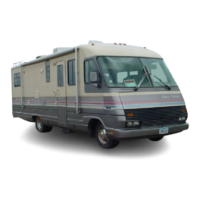MAINTENANCE
Your Pace
Arrow
has been engineered
to
provide driven, individual driving habits, etc.
To
obtain
max
you
with
many
years
of
troublefree service
with
a
imum
tire life,
inspect
tires for
wear
and damag.
minimum
amount
of
maintenance. This
section
will regularly.
If
general tread
wear
indicates
only
1/16'
familiarize you
with
the
areas
of
your
motor
home between any
two
adjacent tread ribs, replace
the
tire
that
require scheduled care. A
few
minutes spent tak-
look
for abnormal wear patterns such as
cupping
0
ingcare
of
your
motor
home
on a regular basis
will
feathering
of
the
tread or rapid
wear
on
either
thE
pay for itself in extended service and
will
protect
your inside
or
outside
of
the
tread surface.
If
these
condi·
investment,
If
you
are mechanically inclined and
tions
exist, an inflation, bearing
adjustment
or
align'
regularly
perform
routine maintenance and repairs on
ment
problem
is
evident. Refer repairs
to
an authorized
your
car
or
truck,
you may
want
to
do
the
mechanical'
Fleetwood Service Center. Replace
the
tire
if
cuts,
work
on
your
motor
home.
If
you prefer,
your
dealer bulges, peeling -tread
or
other
signs
of
damage
or
can perform these
services for you. His trained per- failure are evident. Remove stones and
other
objects
sonnel
will
assure
that
your
motor
home
is maintain- lodged in
the
tread.
Be
certain to
check
wheel
nut
ed and repaired in keeping
with
original performance tightness (using a torque wrench) and
to
adjust
the
expectations. tire pressures,
front
and rear,
after
rotation
to
agree
with
the recommended pressures. Recheck
the
torque
This
section
is intended
to
provide
the
owner
and as recommended in
your
chassis
operator's
manual.
operator
with
a general
overview
of
service and 1
'.
•
."
.','
maintenance
information
for
the
motor
home. In ad- Due·to
their
design, radial tires tend
to
wear
faster
dition
to
providing information for proper maintenance in the shoulder area, particularly in
the
front
positions.
of
the
motor
home,
some
inspection and'
diagnostic
This makes regular rotation especially necessary. Con-
procedures are included
to
help
detect
and
identify
suit
your dealer or
the
chassis
manufacturer's
problem conditions. Detailed service and maintenance operator's or maintenance manual
for
proper tire rota-
information
may
be
found
in
the
chassis
operator's
tlon
procedures.
manual
and
chassis
manufacturer's
service and
maintenance
manuals,
available
from
the
chassis
manufacturer.
While
the
information
contained In
this
section
is
. intended
to
establish proper maintenance and inspec-
'tion
procedures, there may be times
when
more detail-
ed
diagnostic
and repair procedures
may
be required.
Consult
your dealer or an authorized
Fleetwood
Ser-
vice
Center in
these
situations.
LUBRICATION
Various
components
of
the
motor
home
chassis
must
have
the
proper lubrication
to
operate
as
design-
ed. This
lubrication
must
be done in accordance
with
the
intervals specified
in
the
appropriate Maintenance
Schedule
for
the
vehicle.
Consult
the
chassis
manufacturer's
operator's or maintenance manual for
specific.
Information'
concerning
lubricants
and
lubrlcatlon_·
.
WHEELS
AND
TIRES
The
factory
installed tires and wheels are design-
edto
operate
satisfactorily
with
loads up
to
and in-
cluding
the
full
rated load capacity
when
inflated
to
the
recommended
inflation
pressures.
Correct
tire
pressures and driving techniques have
an
important
influence
on tire life. Heavy cornering,
excessively rapid acceleration, and unnecessary sharp
braking
increase tire wear.
Tire
Inspection
and
Rotation
Front and rear tires perform
different
jobs and can
wear
differently
depending on
the
type
of
roads
39
Inflation
Pressure
. Tires
must
be inflated
to
the
maximum
cold
infla-
tion
pressures for
the
tires
when
the
GVWR
or
an
axle GAWR is reached.
Improper
tire
inflation
pressures
for
the
load
the
vehicle is
carrying
can
adversely
affect
tire life and vehicle performance. The
most
common
cause
of
tire failure
is
improper
inflation. .
Too
Iowan
air pressure can result in tire overloading,
abnormal tire wear, adverse vehicle
handling,
reduc-
ed vehicle stability, and reduced fuel economy.
The
tire flexes more and can build
up
excessive
heat,
weakening
the
tire and increasing
susceptibility
to
damage or failure.
Too
high
an air pressure can
result
in abnormal wear, harsh vehicle ride,
and
increased
susceptibility
to
damage
from
road hazards_
lower
inflation pressures should be used
only
with
reduc-
ed vehicle loads,
After
determining
the
load
on
each
tire by weighing
the
vehicle on a scale,
inflate
the
tires
to
the
.
correct
cold
inflation
pressures
for
the
actual tire loads. Refer
to
the
chassis
operator's
manual for additional information on inflation pressure.
Keep an accurate tire gauge in your
tool
kit.
Check
tire pressures cold.
DO
NOT
BLEED
AIR
OUT
OF
WARM TIRES.
Wheel
and
Tire
Balancing
From the standpoints
of
tire
wear
and
vehicle
ride
and handling ease, maintain proper
balance
of
wheel
and tire assemblies. The
two
types
of
balancing
systems in current use balance wheels
either
on
or

